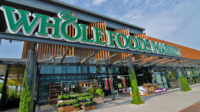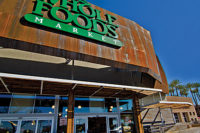Channel Strategies
Natural retailers challenged by inflation, competition
Experts suggest natural retailers promote specialty offerings to appeal to consumers

Image courtesy of Whole Foods Market
In the TV game show “The Price Is Right,” contestants are called from the studio audience to “Come on Down” and take a spot in the front row behind bidding lecterns, known as “Contestants’ Row.” The contestants then compete in a bidding round to determine which will play the next pricing game. The contestant whose bid is closest to the actual retail price of a product, without going over, wins that item and gets to play the subsequent pricing game.
When it comes to the grocery industry, inflation is causing consumers to play a different kind of pricing game — looking to maximize their dollars on nutritious food and beverages. As a byproduct, experts note that fewer consumers are frequenting natural and organic retailers than traditional grocers.
“As of February 2023, more than one in five consumers shopped for groceries in a natural supermarket over the last year,” says Brittany Steiger, senior analyst of retail and eCommerce at Mintel, Chicago. “Mintel’s research suggests that natural markets are less likely to be the primary grocer for most consumers; in 2022 only 6% of consumers identified natural supermarkets as the grocer they shopped most often, compared to 39% who shop most often in traditional supermarkets.
“Still, the outlook is mostly positive and consumers may be more likely to gravitate back to natural grocers as inflation and high grocery prices come down,” Steiger continues.
Sara Ober, retail account manager at Chicago-based SPINS, points to grocers within the natural and organic space as struggling to meet consumer shopping trends.
“[These] retailers have struggled to keep up with the ever-changing demands of the retail landscape in 2023,” she says. “Mid-year trends have shown how important it is to stay agile and in tune through mitigating the effects of inflation, engaging the values-oriented shopper and embracing new technology.”
Shifting behaviors
As inflation is impacting the grocery industry as a whole, experts highlight how consumers’ value-seeking behaviors are further affecting natural and organic retailers.
Mintel’s Steiger points to consumers increasingly scrutinizing the value proposition of the retailers they shop from.
“As a result of high food prices, consumers are paying more attention to how much they spend on groceries and some are putting off buying certain items altogether due to the expense,” she explains. “This price-sensitivity is driving up value-focused behaviors such as deal seeking and coupon clipping, as well as brand and retailer switching, increasing competition from store brands and discount outlets.
“While inflation has been decelerating, it may be a while before consumers find relief at the grocery store shelf,” Steiger continues. “Budget-conscious behaviors are expected to carry through in the short- and medium-term as consumers rebound from economic pressures and wait for prices to come down meaningfully across-the-board.”
SPINS’ Ober points to “shrinkflation,” where consumers are getting less of a product for the same or slightly higher price in various sectors. “As a result of this inflationary period, shoppers have been opting for lower-tier and private label items,” Ober says.
Nevertheless, during times of inflation and economic strain, Ober notes that specialty retailers have a unique advantage.

Image courtesy of Whole Foods Market
“They are typically considered affordable luxuries, serving as destination stores with a wide array of gourmet food products,” she says. “Customers often view these retailers as a way to treat themselves, whether it’s for a lunch out (such as grabbing sushi to-go) or indulging in small pleasures like bakery items or bottles of wine.”
Mintel’s Stegier suggests that consumers’ interest in nutritious food and drinks can benefit natural and organic retailers.
“On a category basis, consumers are prioritizing spending on more nutrient-dense foods, such as proteins and fresh produce items, which may bode well for natural and organic retailers as consumers look to maximize their dollars on nutritious foods and functional ingredients,” she says. “An effective promotional strategy, high-value loyalty program benefits and price transparency remain critical moving forward.”
Meeting health and wellness trends
As consumers continue to prioritize health and wellness, experts highlight how natural and organic retailers can capitalize on these trends.
Mintel’s Steiger points to both health and sustainability initiatives as important, as natural and organic grocers can stand out and deliver incremental value to shoppers.
“Despite a focus on savings, consumers continue to be focused on their health and well-being; 73% of consumers are trying to choose healthier options when shopping for groceries,” Steiger says. “Overall, consumers are willing to invest in their personal health, giving natural grocers an opportunity to provide nutrition guidance and loyalty offerings that support consumers’ overall health goals.
“Conscious consumerism also continues to be a trend as consumers are increasingly mindful of their surroundings and the impact of their consumption behaviors on the environment and their local economy,” she continues. “More than half of consumers are interested in more environmentally friendly shopping options, which can include anything from refillable products to sustainable packaging to in-store recycling programs, while 78% would like to see grocers do more to combat food waste.”
SPINS’ Ober points to functional drink options as a way of capturing shoppers’ attention.
“Notably, digestive functional ingredients have gained widespread attention through viral TikTok trends, like the ‘sleepy girl mocktail,’ featuring prominent functional soda brands like OLIPOP and Poppi,” Ober says. “Furthermore, there’s a rising trend of pairing these sodas with daily probiotic consumption, also seen on social media.”
Moreover, Ober points to beverages designed to enhance mood and cognitive function as on the rise.
“These options are gaining popularity as non-alcoholic alternatives to traditional cocktails,” she says. “Value-oriented shoppers are more inclined to try out new items and are visiting stores more often than other shoppers. Therefore, retailers must ensure that they adjust their product offerings to appeal to these adventurous customers.”

Image courtesy of Whole Foods Market
Keeping up with the times
As value-oriented shoppers continue to combat inflation, experts highlight key factors for natural and organic retailers to take into consideration.
SPINS’ Ober suggests employing value-driven strategies that include loyalty programs, promotions, and a product range that highlights a strong private label program.
“To attract value-oriented consumers who are interested in health and wellness trends, it’s important to note that these shoppers visit stores more frequently, are more adventurous, and are open to experimenting with new brands and products,” she says. “Furthermore, retailers should embrace new technology to connect with consumers effectively.
“With more shoppers willing to purchase groceries and other essentials online, retailers can seize the opportunity to engage with their customers on a deeper level through personalization strategies like promotions, targeted marketing and product recommendations,” Ober continues.
Mintel’s Steiger echoes similar sentiments, noting that omnichannel shopping has become the norm.
“When it comes to eCommerce, natural supermarkets may have a lower online penetration when compared to other grocers, including Amazon, Walmart and traditional supermarkets,” she says. “This suggests that natural grocers have an opportunity to expand their online offerings to improve the online customer experience.
“In terms of what drives consumers to shop for groceries online, convenience continues to be most central — to save time or to ease the purchase of bulk or heavy items,” Steiger continues. “Expanding eCommerce offerings will be key in unlocking convenience and searchability, especially when reaching younger consumers.”
Further, Steiger points to dynamic search as becoming more important to digitally native shoppers such as Gen Z and millennials.
“The growth in generative AI also is expected to further supplement the online experience,” Steiger says. “For example, Instacart has piloted a plugin for ChatGPT in collaboration with Open AI to help users more easily search for grocery items and add them directly to their cart.
To further promote health and wellness concepts, Steiger recommends natural and organic retailers roll out programs and services tailored to consumers making healthy choices.
“Overall, consumers are interested in a variety of concepts both in-store and online, with top options including product samples (both in-store and included with their online orders); in-store fresh produce services (e.g. fresh produce butcher); or locally sourced foods,” she explains. “For the online channel specifically, consumers are most interested in rapid or same-day delivery options, shopping options that reduce waste (such as discounts on items nearing expiration) and shoppable recipes.”
Looking for a reprint of this article?
From high-res PDFs to custom plaques, order your copy today!






